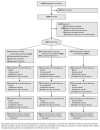Brief intervention for patients with problematic drug use presenting in emergency departments: a randomized clinical trial
- PMID: 25179753
- PMCID: PMC4238921
- DOI: 10.1001/jamainternmed.2014.4052
Brief intervention for patients with problematic drug use presenting in emergency departments: a randomized clinical trial
Erratum in
-
Error in author's name.JAMA Intern Med. 2015 Mar;175(3):470. doi: 10.1001/jamainternmed.2015.1. JAMA Intern Med. 2015. PMID: 25730580 No abstract available.
Abstract
Importance: Medical treatment settings such as emergency departments (EDs) present important opportunities to address problematic substance use. Currently, EDs do not typically intervene beyond acute medical stabilization.
Objective: To contrast the effects of a brief intervention with telephone boosters (BI-B) with those of screening, assessment, and referral to treatment (SAR) and minimal screening only (MSO) among drug-using ED patients.
Design, setting, and participants: Between October 2010 and February 2012, 1285 adult ED patients from 6 US academic hospitals, who scored 3 or greater on the 10-item Drug Abuse Screening Test (indicating moderate to severe problems related to drug use) and who were currently using drugs, were randomized to MSO (n = 431), SAR (n = 427), or BI-B (n = 427). Follow-up assessments were conducted at 3, 6, and 12 months by blinded interviewers.
Interventions: Following screening, MSO participants received only an informational pamphlet. The SAR participants received assessment plus referral to addiction treatment if indicated, and the BI-B participants received assessment and referral as in SAR, plus a manual-guided counseling session based on motivational interviewing principles and up to 2 "booster" sessions by telephone during the month following the ED visit.
Main outcomes and measures: Outcomes evaluated at follow-up visits included self-reported days using the patient-defined primary problem drug, days using any drug, days of heavy drinking, and drug use based on analysis of hair samples. The primary outcome was self-reported days of use of the patient-defined primary problem drug during the 30-day period preceding the 3-month follow-up.
Results: Follow-up rates were 89%, 86%, and 81% at 3, 6, and 12 months, respectively. For the primary outcome, estimated differences in number of days of use (95% CI) were as follows: MSO vs BI-B, 0.72 (-0.80 to 2.24), P (adjusted) = .57; SAR vs BI-B, 0.70 (-0.83 to 2.23), P (adjusted) = .57; SAR vs MSO, -0.02 (-1.53 to 1.50), P (adjusted) = .98. There were no significant differences between groups in self-reported days using the primary drug, days using any drug, or heavy drinking days at 3, 6, or 12 months. At the 3-month follow-up, participants in the SAR group had a higher rate of hair samples positive for their primary drug of abuse (265 of 280 [95%]) than did participants in the MSO group (253 of 287 [88%]) or the BI-B group (244 of 275 [89%]). Hair analysis differences between groups at other time points were not significant.
Conclusions and relevance: In this sample of drug users seeking emergency medical treatment, a relatively robust brief intervention did not improve substance use outcomes. More work is needed to determine how drug use disorders may be addressed effectively in the ED.
Trial registration: clinicaltrials.gov Identifier:NCT01207791.
Comment in
-
Screening, brief intervention and referral of emergency department patients with unhealthy drug use: efficacious or not?Evid Based Ment Health. 2015 Nov;18(4):e8. doi: 10.1136/eb-2014-102037. Epub 2015 Oct 12. Evid Based Ment Health. 2015. PMID: 26459472 Free PMC article. No abstract available.
References
-
- Substance Abuse and Mental Health Services Administration . Results from the 2012 National Survey on Drug Use and Health: Summary of National Findings. Substance Abuse and Mental Health Services Administration; Rockville, MD: 2013.
-
- Schiller JS, Lucas JW, Peregoy JA. Summary health statistics for U.S. adults: National Health Interview Survey, 2011. National Center for Health Statistics; Hyattsville, MD: 2012. - PubMed
-
- Substance Abuse and Mental Health Services Administration . Systems-Level Implementation of Screening, Brief Intervention, and Referral to Treatment. Vol 33. Substance Abuse and Mental Health Services Administration; Rockville, MD: 2013.
Publication types
MeSH terms
Associated data
Grants and funding
- U10 DA013046/DA/NIDA NIH HHS/United States
- U10 DA020036/DA/NIDA NIH HHS/United States
- UG1 DA013714/DA/NIDA NIH HHS/United States
- U10 DA013732/DA/NIDA NIH HHS/United States
- K24 DA022412/DA/NIDA NIH HHS/United States
- HHSN271200900034C/DA/NIDA NIH HHS/United States
- U10 DA013720/DA/NIDA NIH HHS/United States
- U10 DA015831/DA/NIDA NIH HHS/United States
- U10 DA013035/DA/NIDA NIH HHS/United States
- U10 DA013714/DA/NIDA NIH HHS/United States
- U10DA015833/DA/NIDA NIH HHS/United States
- U10DA013714/DA/NIDA NIH HHS/United States
- U10 DA015833/DA/NIDA NIH HHS/United States
LinkOut - more resources
Full Text Sources
Other Literature Sources
Medical
Miscellaneous


